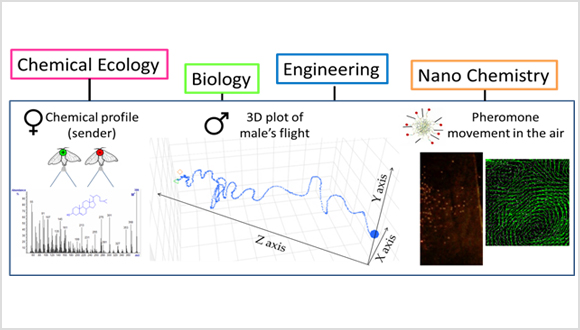דוקטורנטים מספרים - Yiftach Golov
Sexual communication in moths: A novel mechanism for detecting odor
Yiftach Golov
Supervisor: Prof. Alexander Liberzon
Biomimicry is a fundamental feature of modern science, whereby Nature’s treasure chest has been used as a source of inspiration for scientific innovations. This bio-emulation approach has made an enormous contribution nowadays, in different domains such as medicine, agriculture, public transportation, bio-energy and more. Notably, the feasibility of biomimicry research depends upon the involvement of different scientific fields, i.e. a multidisciplinary approach.
My name is Yiftach Golov, and I'm a Ph.D. student at the Porter School of Environmental Science at Tel-Aviv-University. My research deals with chemical sourcing; we use moths as a biomimicking model. Moths are a great model for chemical sourcing because they use chemical communication based on a volatile substance to reproduce (Figure 1). Generally, the female (i.e. the 'sender') "calls to the male" by releasing a sex pheromone (i.e. the mediator), then the pheromone is propagated in the air and finally reaches the antennas of the male (i.e. the 'receiver'), which enables him to locate the female. Thus, moth sexual communication provides a unique multi-layered platform that involves different beings and disciplines.
Surprisingly, although moth sexual communication has been studied extensively, research is still lacking regarding some fundamental aspects. For example, the precise distribution of sex pheromones in the air is still unknown. Furthermore, the male’s locating mechanism of the female is not fully understood. To shed light on the mechanism of chemical communication in moths, my research utilizes innovative methods which are derived from various disciplines such as: biology, engineering, ecology and nano-chemistry (Fig. 2).

Fig. 2. A schematic display of the different disciplines on which this research depends, with specific emphasis on several aspects that are being studied.
Hopefully, my multidisciplinary research will provide new insights about sexual communication via volatile substances in moths. Such knowledge can have a significant impact on many facets of science, including: evolutionary biology, robotics, artificial intelligence, pollution monitoring and sustainable pest control. Indeed, this research reflects the very essence of Albert Einstein’s famous words when he stated, "Look deep into nature, and then you will understand everything better.”


